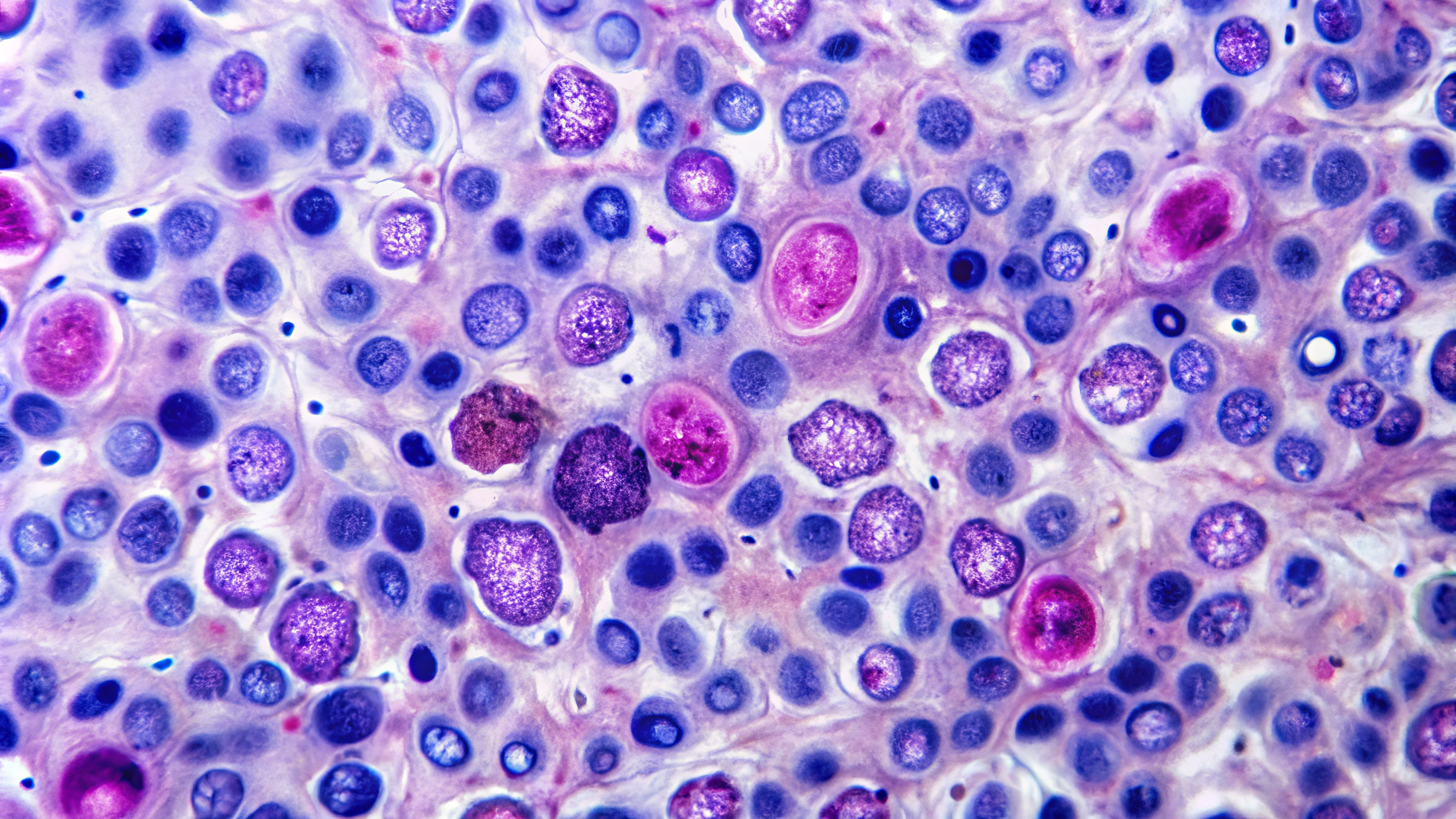Commentary
Article
EHA 2025: BMS-986458 Shows Clinical Promise in FL and DLBCL
Franck Morschhauser, MD, PhD, discusses the novel cereblon-dependent bifunctional degrader BMS-986458, highlighting its selective targeting of BCL6, promising early efficacy in relapsed/refractory lymphoma, favorable safety profile, and future potential in combination regimens and earlier treatment lines.
As precision medicine continues to redefine therapeutic strategies in hematologic malignancies, novel approaches such as targeted protein degradation are rapidly gaining traction. Among the emerging agents in this space is BMS-986458 (Bristol Myers Squibb), a cereblon-dependent bifunctional degrader designed to selectively eliminate the oncogenic transcription factor BCL6, a key driver of lymphomagenesis in both relapsed/refractory diffuse large B-cell lymphoma (R/R DLBCL) and follicular lymphoma (FL).
In this interview, Pharmacy Times® sat down with Franck Morschhauser, MD, PhD, professor of hematology at the University of Lille and Hospital Claude Huriez and current chair of the Lymphoma Study Association in France, to discuss the scientific rationale behind BMS-986458, its early safety and efficacy data, and the potential implications for pharmacy professionals managing advanced lymphoma. Following the presentation of data in abstract 4160340 at the European Hematology Association (EHA) 2025 Congress, Morschhauser shares insights into the molecule’s bifunctional design, pharmacodynamic properties, and tolerability profile, while also outlining its future potential in combination regimens and earlier lines of therapy.
Pharmacy Times: Can you explain how BMS-986458’s bifunctional cereblon-dependent design differentiates it from traditional immunomodulators and other BCL6 inhibitors currently in development or clinical use?
Franck Morschhauser, MD, PhD, is a professor of hematology at the University of Lille and Hospital Claude Huriez and current chair of the Lymphoma Study Association in France.

Franck Morschhauser, MD, PhD: Historical ligand-directed degraders or proteolysis targeting chimeras tend to be large molecules and too big for clinical development. BMS-986458 is a uniquely small heterobifunctional agent that works extremely well at degrading its target protein, BCL6, in human tumors. It is different from other immunomodulatory drugs (IMiDs) and cereblon E3 ligase modulatory drugs (CELMoDs) in that it very selectively degrades a critical oncogenic factor, BCL6, which has been pursued as a high value target in non-Hodgkin lymphoma for many years. Only by leveraging a targeted protein degradation approach we can design molecules that are both highly selective and potent enough to address the rapid-turnover rates of this highly expressed oncogene.
Pharmacy Times: Given that BCL6 dysregulation contributes to both apoptosis evasion and tumor proliferation, what is the rationale for targeting BCL6 over other transcriptional repressors in R/R DLBCL and FL?
Morschhauser: In addition to ectopically suppressing these pathways outside of the normal cellular processes, which eventually leads to malignant transformation, BCL6 plays a key role within the surrounding immune microenvironment that specifically supports the survival of malignant B-cells. In this way, BMS-986458 leverages a powerful complementarity between the tumor cell intrinsic dependency on BCL6 and the functionality within the lymphoma microenvironment to drive deep tumor control and killing.
Pharmacy Times: What have you observed so far regarding the dose-exposure relationship and BCL6 degradation levels across the once-daily and twice-daily dosing schedules?
Morschhauser: For dose-exposure relationship, preliminary pharmacokinetic data suggest dose proportional increase in exposure with both twice-daily and once-daily dosing. Generally, steady-state exposure is higher with twice-daily and once-daily dosing at a given dose level. Interindividual variability is high so conclusions of linearity cannot be made at this time.
Deep and sustained BCL6 degradation is observed already at the lowest doses tested (40 mg twice-daily and 80 mg once-daily) in the peripheral blood. A trend toward deeper degradation at higher doses in tumor B cells from lymph nodes is observed.
Pharmacy Times: How closely do peripheral blood BCL6 degradation levels correlate with tumor response or progression, and could this serve as a pharmacodynamic biomarker for clinical monitoring?
Morschhauser: Given the rapid and strong BCL6 degradation observed across all dose levels tested it is complicated to see any correlation with response, tumor shrinkage or durability of responses. To note, the lack of strong correlation between the level of target degradation and response is common across protein degraders suggesting that additional mechanisms such as downstream factors, on-target off-tumor or immunomodulatory effects participate in the anti-tumor activity.
Pharmacy Times: With no grade 3 or higher hematologic treatment-related adverse events reported, how does the safety profile of BMS-986458 compare to other cereblon-modulating therapies, and what implications might this have for long-term use?
Morschhauser: The lack of significant hematological toxicity especially neutropenia or thrombocytopenia is a clear advantage over other cereblon modulating therapies as it should theoretically ease combinability with chemotherapy or other effective agents. What remains to be established is the longer term non hematological safety profile, such as polyneuropathy also seen with IMIDs, or musculoskeletal skeletal and connective tissue disorders which were observed in some patients and may impact total treatment duration or lead to test alternative treatment schedules with one week drug holiday within a given cycle such as done with lenalidomide (Revlimid; Celgene Corporation) or golcadomide (BMS-986369; Bristol Myers Squibb).
Microscopic view of abnormal lymph node tissue with distinctive follicular pattern, characteristic of follicular lymphoma. Image Credit: © Man888 - stock.adobe.com

Pharmacy Times: With 10 out of 13 efficacy-evaluable patients achieving an objective response, including 3 complete responses, how do you interpret this activity in such a heavily pretreated population?
Morschhauser: The preliminary activity in this particularly heavily pretreated patient population whose disease is refractory to most available therapies including CAR T and bispecifics is very promising, but durability of response is also key and longer follow-up is needed to confirm this very encouraging efficacy signal.
Pharmacy Times: What are the key factors that might guide future patient selection, especially for pharmacists involved in therapy triage—prior exposure to CELMoDs, refractory disease status, or molecular subtype?
Morschhauser: As of now, there is no established biomarker to help select patients but this is an area of active research. Given the high objective response rate in both DLBCL and FL, this clinical trial will further evaluate this drug primarily in both refractory patients with DLBCL and FL with no other treatment options, but the goal is to introduce this compound in earlier lines and even in first line in selected group of patients with both FL and DLBCL in unmet need.
Pharmacy Times: Given the activity seen in both FL and DLBCL, are there differences in response or tolerability between these histologies that pharmacists should be aware of?
Morschhauser: The complete response rate seems higher in patients with FL but may also reflect a longer exposure to the drug in patients with less aggressive and proliferative disease. As a consequence of this longer exposure to the drug, the safety profile might be different in FL, and we’ll carefully follow the emergence of polyneuropathy, musculoskeletal skeletal and connective tissue disorders and infections on the long run.
Pharmacy Times: As you move into expansion cohorts or future combination studies, what opportunities do you see for integrating BMS-986458 into treatment pathways that include bispecifics or anti-CD20 antibodies?
Morschhauser: Combination with anti CD20 and bispecifics is clearly the next step and is already planned in the current protocol.
Newsletter
Stay informed on drug updates, treatment guidelines, and pharmacy practice trends—subscribe to Pharmacy Times for weekly clinical insights.





